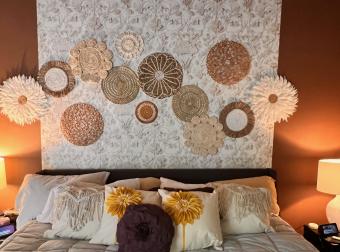
Nothing beats a beautiful antique that also serves a practical function. In today's homes, space and storage are always at a premium, but antique sideboards are a stylish (and often valuable) solution to the problem of where to keep all the little odds and ends in your dining area. From your grandma's china to the kids' art supplies, it all fits inside a sideboard.
How to Identify an Antique Sideboard
As you shop in antique stores or online, it's important to be able to tell whether what you're looking at is a sideboard or something else. The main difference between a vintage or antique sideboard and a buffet is the size. An antique buffet tends to be bigger - we're talking taller legs and just overall length. The thing is, these terms do get used interchangeably, so if you're searching classified ads, check for both buffets and sideboards.
No matter what it's called, identifying an antique sideboard means giving it a close look (or at least looking carefully at any photos included in the listing for it).
- Check for labels and marks. These can tell you about the manufacturer, the age, and where the piece was made. Look on the back and underside.
- Look at the hardware. Antique furniture hardware offers clues about the age of the piece. Look for machine-made screws, nails, keyholes, and handles after the mid-19th century.
- Examine drawer construction. Drawers offer a clue about whether a piece is modern, vintage, or antique. Antique furniture tends to have dovetailed drawers, and the drawers on older pieces will also feature solid wood.
Value of Antique and Vintage Sideboards
How much an antique sideboard is worth will depend on several factors, including its condition, age, craftsmanship, and beauty. As with all antique furniture, if you suspect you have something super valuable, it's always worth having professionally appraised. Otherwise, to get a sense of how much it's worth, you can compare the piece to similar ones that have sold recently.
In general, antique sideboards sell between $500 and $1500, but they can be much more valuable if they feature fine craftsmanship, are in exceptional condition, or are very old. Take a careful look at your piece and compare it to recently sold examples.
- A tiger oak sideboard with a mirrored back sold for just under $900. It was in very good condition and dated to the last half of the 19th century.
- A vintage sideboard that was refinished and painted bright blue sold for about $200. Often, pieces with the original finish are worth more than those that have been painted.
- An Art Nouveau sideboard with elaborate carvings and beautiful details sold for over $4,250. It dated to about 1900 and featured incredible craftsmanship.
- A vintage mid-century sideboard with a simple design and good quality craftsmanship sold for just under $1,000.
Tips for Buying and Selling Sideboards
If you're considering buying or selling a piece like this, it's important to keep a few things in mind:
- Try to buy and sell locally. Shipping something like a sideboard can cost hundreds of dollars, adding to the price you'll have to pay or cutting into your profit margin.
- Use multiple terms in your listing or search. Besides calling it a "sideboard," people may call it a credenza, buffet, storage unit, or even china cabinet.
- Consider the condition when you're negotiating. Wood furniture with stains, splits, and other damage is almost always worth less.
- Check dimensions. With pieces this large, it's important to make sure the item will fit in your home and the room you have in mind.
Five Surprising Uses for Antique Sideboards
Traditionally, an antique sideboard is used for storing dishes and linens in your dining room, but there are a ton of great ways to put this hard-working piece of furniture to good use.

- Entryway - Use a sideboard in your hall or entryway to hold hats and mittens, dog leashes, keys, and anything else you need to store there. You could even sort mail in a drawer.
- Bathroom - Try a sideboard in the bathroom for a vintage feel. It makes great storage for towels, soap, and all kinds of toiletries.
- Child's room - A sideboard can work as a storage piece in kids' bedrooms or even as a changing table in the nursery. The drawers and cupboards are great for storing anything from diapers to toys.
- Home office - If there's ever a room that always needs better storage, it's the home office. A sideboard can be a great solution for all those papers and office supplies.
- Living room - Keep kids' toys out of sight or store your record collection in an antique sideboard in your living room. You can also use it to keep extra throw blankets, board games, and anything else you need to store.
Perfect Alone or With Other Antiques
A sideboard can be just the beginning of your antique furniture collection, but it doesn't have to be. These are great pieces that work well on their own or as part of a vintage or farmhouse interior decorating look. Whether you're a collector or just need a great piece to store your extra stuff, enjoy the beauty of these super functional antiques.







